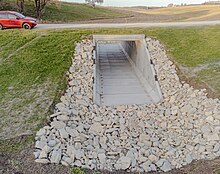
Back بربخ (بناء) Arabic Кульверт Byelorussian কালভার্ট Bengali/Bangla Canonada de drenatge Catalan Propustek Czech Durchlass German Kulverto Esperanto Obra de drenaje Spanish Truup Estonian زیرآبگذر Persian






A culvert is a structure that channels water past an obstacle or to a subterranean waterway. Typically embedded so as to be surrounded by soil, a culvert may be made from a pipe, reinforced concrete or other material. In the United Kingdom, the word can also be used for a longer artificially buried watercourse.[1]
Culverts are commonly used both as cross-drains to relieve drainage of ditches at the roadside, and to pass water under a road at natural drainage and stream crossings. When they are found beneath roads, they are frequently empty. A culvert may also be a bridge-like structure designed to allow vehicle or pedestrian traffic to cross over the waterway while allowing adequate passage for the water. Dry culverts are used to channel a fire hose beneath a noise barrier for the ease of firefighting along a highway without the need or danger of placing hydrants along the roadway itself.
Culverts come in many sizes and shapes including round, elliptical, flat-bottomed, open-bottomed, pear-shaped, and box-like constructions. The culvert type and shape selection is based on a number of factors including requirements for hydraulic performance, limitations on upstream water surface elevation, and roadway embankment height.[2]
The process of removing culverts to restore an open-air watercourse is known as daylighting. In the UK, the practice is also known as deculverting.[3]
- ^ Taylor, Karl (2010). "Thacka Beck Flood Alleviation Scheme, Penrith, Cumbria – Measured Building Survey of Culverts". Oxford Archaeology North.
- ^ Turner-Fairbank Highway research Center (1998). "Hydraulic Design of Highway Culverts" (PDF), Report #FHWA-IP-85-15 US Department of Transportation, Federal Highway Administration, McLean, Virginia.
- ^ Wild, Thomas C. (2011). "Deculverting: reviewing the evidence on the 'daylighting' and restoration of culverted rivers". Water and Environment Journal. 25 (3): 412–421. doi:10.1111/j.1747-6593.2010.00236.x. S2CID 111280203.
© MMXXIII Rich X Search. We shall prevail. All rights reserved. Rich X Search